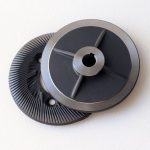Grain grinders come in three basic types:
- Stone
- Burr
- Impact
Stone Grinders are the oldest type of grinder there is and was the only kind until only a few years ago. Stone grinders have two circular grinding stones. One stone turns against a stationary stone. Grooves are cut, radiating out from the center of the stone. These grooves diminish until they disappear towards the outer edges. When grain is ground, it falls through a channel into the center of the two stones. As the rotating stone turns, it pulls the grain out through the channels and is ground, with the flour falling out the outer edges of the two stones. A hundred years ago these stones were often two or three feet across, weighed hundreds of pounds and were turned by windmills or water wheels. In modern home grinders these stones are small, usually only about three inches in diameter. They are not natural stones like the grinders of yesteryear, but are made from very hard materials that will last a life time if used with care.
Burrs are similar to stones except their grinding wheels are made out of steel. These burrs are sometimes referred to as teeth in grinder advertisements. Burr grinders have some advantages and disadvantages over stone grinders. One advantage is that grinding dry grains as well as oil bearing seeds will not clog or "load up" on the burr. The disadvantage is that it will not grind as finely as a stone grinder.
Impact grinders use 'blades' placed in circular rows on metal wheels. One wheel turns and the other wheel is stationary like the manual grinders. But this is where the similarities end. When the two wheels are put together the rows of blades inter-mesh, running microscopically close, yet never touching the blades from the opposite wheel. The rotating wheel turns at several thousand RPM. As grain is fed into the center of the fixed wheel, the interaction between the two wheels 'impacts' the grain and literally pulverizes it into a fine powder as the grain works its way to the outside of the wheels. The Wonder Mill is an impact grinder.



